It’s common to hear people say cats are “untrainable,” but the fact is that with the appropriate approach, you can teach them. Clicker training for cats is a widespread practice for cat owners. The technique is effective with felines; with some work, your cat will soon wow visitors to your home with their new talents.
Cats may be taught tricks, led through agility courses, coaxed to the vet, and settled around other animals with the help of clicker training.
This well-known teaching method only requires a little adjustment to make it suitable for cats. Let’s explore this fantastic training technique with Canvas Personalized.
Fundamentals of Clicker for Training Cats
With the help of a clicker, an animal can be trained to associate a joyous sound with positive action, a form of “second-order” positive reinforcement training. You have likely seen a clicker in action if you have looked for videos on the internet that include teaching a cat.
The Concept Of A “Clicker”
To teach your cat to do anything from the practical “sit” and “stay” to the more amusing “wave” and “fetch,” all you need is a small device like a clicker and a little bit of time.

A clicker is a tiny plastic object with a metal tongue that you press to make a “click” sound. The loud noise produced by a conventional box clicker could be intimidating to some cats. Thus, choosing the “clickers” that make a more mellow noise could be more attractive to cats.
What Is The Function Of Clicker Training for Cats?
In part because the click sound conveys the exact moment when a kitten does something right. And using a clicker can make clicker training for cats easier and faster. When using a clicker to train an animal, the first step is to get the animal to associate the click with a positive experience. Once he realizes a treat always follows the click, he’ll be able to associate it with desirable actions.
Do You Need A Clicker To Train Cat?
Without a doubt! If you don’t have a clicker handy, you can always use a pen with a clicking mechanism, click your tongue, or say a word like “yes” to indicate your choice. While professional cat trainers widely use clickers, any novel sound used frequently and consistently will have the same effect. If you don’t have a physical clicker, you can always use your smartphone as a clicker.
Step-By-Step Clicker Training For Cats
Finding the Right Reward
To begin clicker training cats, you first must discover an extremely enticing treat. Due to the nature of clicker training, which involves immediately rewarding desirable behaviors after they have been marked with a click, this is the case.

Many cats aren’t used to being taught, so choosing the right reward for your cat is important. But, for felines that aren’t motivated by food, even a few seconds of play with a toy might be enough to excite them.
Step 1: Let cats see the reward
Place cat treats in a whole food bowl or saucer and sits with the pet.
Step 2: Press the clicker
To train your cat to respond to the clicker, press the button twice and toss a tasty treat.
Step 3: Get the cat used to the sound
If your cat seems to enjoy this, you should do it again at sporadic intervals.
Step 4: Link the connection between the reward and clicker
As your cat learns that the clicker means a treat is coming, he may start to look for the treat instead of the clicker when he hears the click.
Introducing Your Cat to the Clicker
Discover the amount of time your cat would be willing to learn. Training sessions should last no more than a few minutes since cats have even shorter attention spans than dogs. This is usually the most challenging part when carrying a training clicker for cats. You’ll see success after a few training sessions with your cat.

Step 5: Get the cat’s attention with treats and a clicker
To begin, get your cat’s attention. Hold the treat in one hand and the clicker in the other, and bring both close to the cat’s nose.
Step 6: Use the hand signal
As he starts sniffing the reward, move it in an arc from his nose to the right between his ears. See how your cat follows the arc with its eyes and nose; as its chin goes up and back, its posterior will drop.
Step 7: Reward
When training cats, click and reward your cat as soon as his bottom touches the floor; timing is key.
Step 8: Use positive reinforcement
Do this multiple times during your session.
Helpful Tips for Training Clicker for Cats

Training your cat may take some time, just like training any other animal. Here are some “dos” and “don’ts” of clicker training your cat that will help you get the best results possible.
- Choose a clicker that your cat responds to
Some cats may be frightened by a sharp, loud click that is effective for dogs. It is recommended to try clicking a pen or a Snapple lid if your cat is still bothered by the noise, but it advises sticking to whatever “click” you and your cat decides upon.
- It is best practice to train many cats one at a time
Teaching each cat a unique clicker association and a set of commands is crucial. Otherwise, your every click might be delivering the wrong message. When more cats know their orders, getting things done is easier.
- Do not use clicker training cat to stop bad behavior
You need an obvious connection between cause and effect, including behavior, a click, and a reward. Adding more to the system weakens the reaction and confuses the signal.
Training Clicker For Cats FAQs
- When Is an Appropriate Time to Begin Clicker Train?
In general, clicker training for cats is most effective when it begins when the cat is under three months old, though many cats of any age can be trained. Once your new kitten has graduated to solid foods, you can begin rewarding good behavior quickly. Use their regular wet food or diet as an incentive; they’re still too young to overindulge in treats. If your cat responds to treats or toys, it is never too late to begin clicker training.
- When it comes to a clicker training session, how often is suitable?
You should clicker training your cat at least once a day for 5 minutes at first so that the lessons stick in the cat’s mind. There is no requirement for lengthy training sessions. It has been proven that shorter is better with clicker training kitten.
When training cats, you want them to pay attention the whole time. Reflect on the focus of your cat. They probably won’t be able to concentrate on training for more than five minutes at a time. Ever since your cat has mastered basic training and expresses interest in further sessions, you can increase the number of training sessions daily. We can easily fit in two or more 3-minute workouts per day.
Suppose your cat seems bored or distracted during training, regardless of how many sessions you’ve scheduled. In that case, it’s time to either reduce the duration of the clicker train or the frequency with which it occurs or to increase the value of the reward being offered.
- Instances of Unwanted Behaviors: Could You Use a Clicker?
Finally, we never click a cat as a form of punishment. Clickers are for positive reinforcement, not to punish bad behavior. Cattle cats have a poor capacity for taking correction. You can be sure they won’t think of you fondly if they associate you with nasty things like punishment. Punishing your cat is not intelligent because cats often avoid being around people who treat them harshly.
>>> Read more:
Cats can be taught far more than we give them credit for. You can improve your relationship with your cat by following these simple, rewarding training steps. When used properly, clicker training for cats can positively affect your cat’s behavior. We at Canvas Personalized hope you have great success taming your cat. We really hope you’ve learned a lot from this guide.










